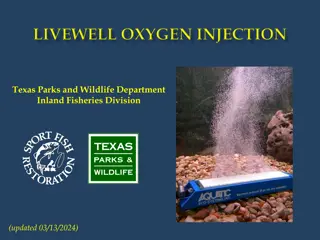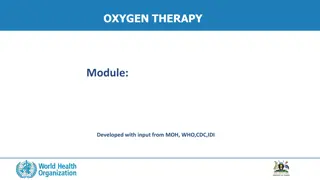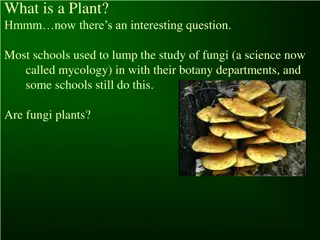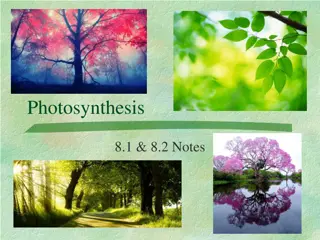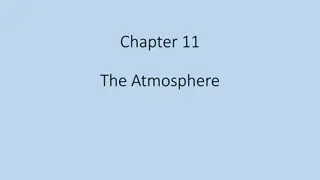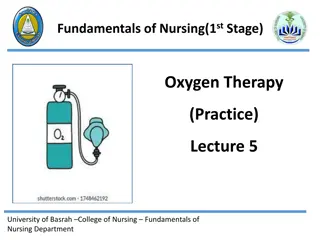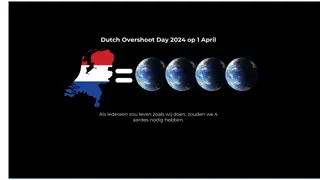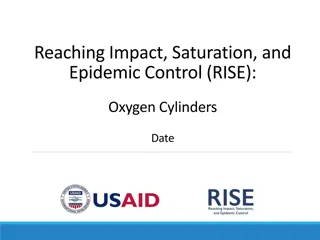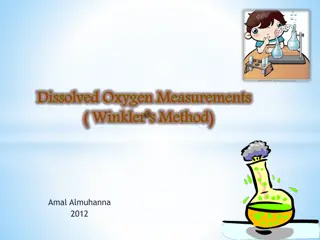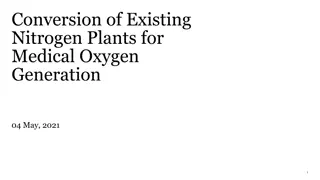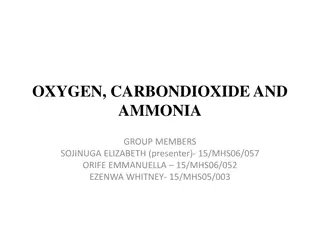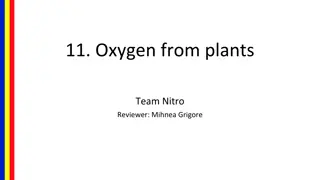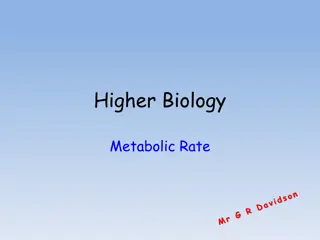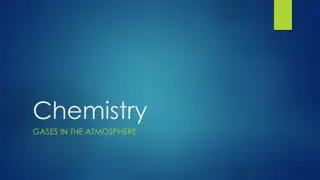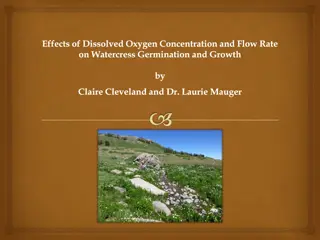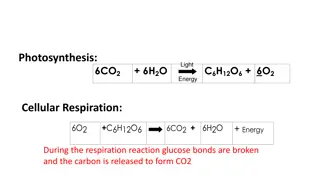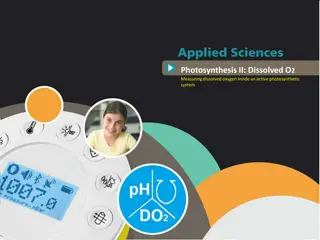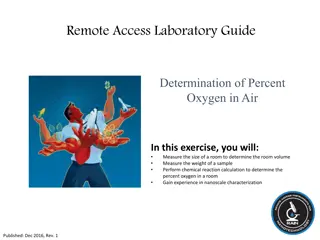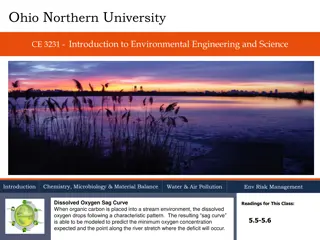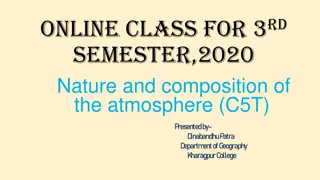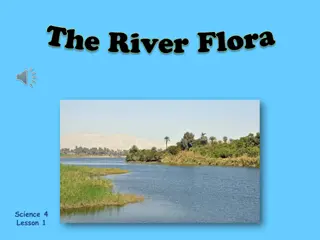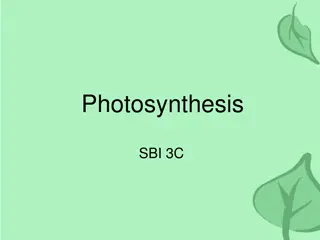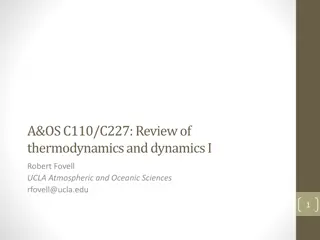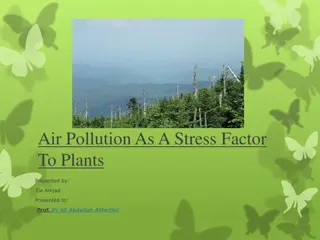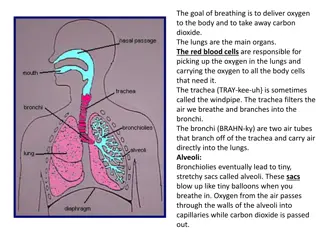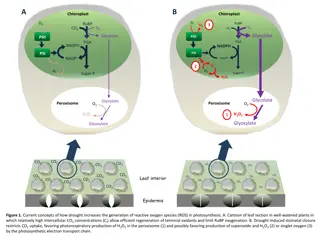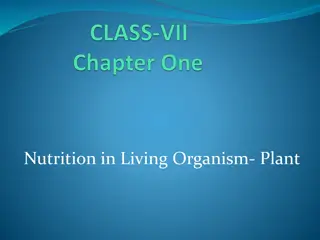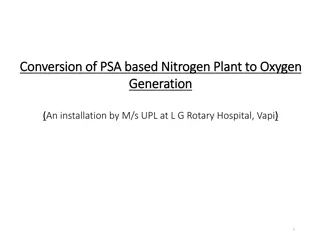Evolution of Earth's Atmosphere and the Role of Plants in Oxygen Production
Earth's atmosphere has evolved over billions of years, with plants and algae playing a crucial role in producing oxygen through photosynthesis. This process gradually increased oxygen levels, enabling the evolution of animals. The reduction of carbon dioxide levels by plants absorbing it for photosynthesis also led to the formation of oceans and the early atmosphere. Human activities, such as burning fossil fuels, have contributed to the increase of greenhouse gases, leading to climate change and its associated effects on the environment and wildlife.
Download Presentation

Please find below an Image/Link to download the presentation.
The content on the website is provided AS IS for your information and personal use only. It may not be sold, licensed, or shared on other websites without obtaining consent from the author. Download presentation by click this link. If you encounter any issues during the download, it is possible that the publisher has removed the file from their server.
E N D
Presentation Transcript
Gas Percentage These produced the oxygen that is now in the atmosphere, through photosynthesis. carbon dioxide + water glucose + oxygen 6CO2 + 6H2O C6H12O6 + 6O2 Proportions of Algae and plants atmosphere gases in the Nitrogen ~80% Oxygen ~20% Over the next billion years plants evolved to gradually produce more oxygen. This gradually increased to a level that enabled animals to evolve. Argon 0.93% Oxygen in the atmosphere First produced by algae 2.7 billion years ago. Carbon dioxide 0.04% How oxygen increased Reducing carbon dioxide in the atmosphere These gradually reduced the carbon dioxide levels in the atmosphere by absorbing it for photosynthesis. This released gases (mainly CO2) that formed to early atmosphere and water vapour that condensed to form the oceans. The Earth s early atmosphere Billions of years ago there was intense volcanic activity Algae and plants How carbon dioxide decreased Volcano activity 1st Billion years Remains of biological matter falls to the bottom of oceans. Over millions of years layers of sediment settled on top of them and the huge pressures turned them into coal, oil, natural gas and sedimentary rocks. The sedimentary rocks contain carbon dioxide from the biological matter. These are made out of the remains of biological matter, formed over millions of years Composition and evolution of the atmosphere Formation of sedimentary rocks and fossil fuels Nitrogen was also released, gradually building up in the atmosphere. Small proportions of ammonia and methane also produced. Released from volcanic eruptions Other gases AQA GCSE Chemistry of the atmosphere Greenhouse gases CO2 and methane as greenhouse gases This formed carbonate precipitates, forming sediments. This reduced the levels of carbon dioxide in the atmosphere. Reducing carbon dioxide in the atmosphere Carbon dioxide, water vapour and methane Examples of greenhouse gases that maintain temperatures on Earth in order to support life When the oceans formed, carbon dioxide dissolved into it Common atmospheric pollutants Carbon footprints Radiation from the Sun enters the Earth s atmosphere and reflects off of the Earth. Some of this radiation is re-radiated back by the atmosphere to the Earth, warming up the global temperature. Global climate The total amount of greenhouse gases emitted over the full life cycle of a product/event. This can be reduced by reducing emissions of carbon dioxide and methane. The greenhouse effect Atmospheric pollutants from fuels change Properties and effects of atmospheric pollutants Source of atmospheric pollutants. Most fuels may also contain some sulfur. Combustion of fuels Human activities and greenhouse gases Human activities that increase carbon dioxide levels include burning fossil fuels and deforestation. Effects of climate change Carbon monoxide Toxic, colourless and odourless gas. Not easily detected, can kill. Carbon dioxide Carbon dioxide, water vapour, carbon monoxide, sulfur dioxide and oxides of nitrogen. Rising sea levels Gases from burning fuels Sulfur dioxide and oxides of nitrogen Human activities that increase methane levels include raising livestock (for food) and using landfills (the decay of organic matter released methane). Cause respiratory problems in humans and acid rain which affects the environment. Extreme weather events such as severe storms Methane Change in amount and distribution of rainfall Solid particles and unburned hydrocarbons released when burning fuels. There is evidence to suggest that human activities will cause the Earth s atmospheric temperature to increase and cause climate change. Particulates Cause global dimming and health problems in humans. Climate change Changes to distribution of wildlife species with some becoming extinct Particulates better hope brighter future
Gas Percentage These produced the oxygen that is now in the atmosphere, through photosynthesis. carbon dioxide + water glucose + oxygen 6CO2 + 6H2O C6H12O6 + 6O2 Proportions of atmosphere gases in the ~80% ~20% Over the next billion years plants evolved to gradually produce more oxygen. This gradually increased to a level that enabled animals to evolve. 0.93% First produced by algae 2.7 billion years ago. 0.04% How oxygen increased These gradually reduced the carbon dioxide levels in the atmosphere by absorbing it for photosynthesis. This released gases (mainly CO2) that formed to early atmosphere and water vapour that condensed to form the oceans. The Earth s early atmosphere Billions of years ago there was intense volcanic activity Algae and plants How carbon dioxide decreased Remains of biological matter falls to the bottom of oceans. Over millions of years layers of sediment settled on top of them and the huge pressures turned them into coal, oil, natural gas and sedimentary rocks. The sedimentary rocks contain carbon dioxide from the biological matter. These are made out of the remains of biological matter, formed over millions of years Composition and evolution of the atmosphere Nitrogen was also released, gradually building up in the atmosphere. Small proportions of ammonia and methane also produced. Released from volcanic eruptions AQA GCSE Chemistry of the atmosphere Greenhouse gases CO2 and methane as greenhouse gases This formed carbonate precipitates, forming sediments. This reduced the levels of carbon dioxide in the atmosphere. Examples of greenhouse gases that maintain temperatures on Earth in order to support life When the oceans formed, carbon dioxide dissolved into it Common atmospheric pollutants Carbon footprints Radiation from the Sun enters the Earth s atmosphere and reflects off of the Earth. Some of this radiation is re-radiated back by the atmosphere to the Earth, warming up the global temperature. Global climate The total amount of greenhouse gases emitted over the full life cycle of a product/event. This can be reduced by reducing emissions of carbon dioxide and methane. Atmospheric pollutants from fuels change Properties and effects of atmospheric pollutants Source of atmospheric pollutants. Most fuels may also contain some sulfur. Human activities and greenhouse gases Human activities that increase carbon dioxide levels include burning fossil fuels and deforestation. Effects of climate change Toxic, colourless and odourless gas. Not easily detected, can kill. Carbon dioxide, water vapour, carbon monoxide, sulfur dioxide and oxides of nitrogen. Rising sea levels Human activities that increase methane levels include raising livestock (for food) and using landfills (the decay of organic matter released methane). Cause respiratory problems in humans and acid rain which affects the environment. Extreme weather events such as severe storms Change in amount and distribution of rainfall Solid particles and unburned hydrocarbons released when burning fuels. There is evidence to suggest that human activities will cause the Earth s atmospheric temperature to increase and cause climate change. Cause global dimming and health problems in humans. Changes to distribution of wildlife species with some becoming extinct better hope brighter future
Gas Percentage carbon dioxide + water glucose + oxygen 6CO2 + 6H2O C6H12O6 + 6O2 Proportions of Algae and plants atmosphere gases in the Nitrogen Oxygen Over the next billion years plants evolved to gradually produce more oxygen. This gradually increased to a level that enabled animals to evolve. Argon Oxygen in the atmosphere Carbon dioxide How oxygen increased Reducing carbon dioxide in the atmosphere These gradually reduced the carbon dioxide levels in the atmosphere by absorbing it for photosynthesis. This released gases (mainly CO2) that formed to early atmosphere and water vapour that condensed to form the oceans. The Earth s early atmosphere How carbon dioxide decreased Volcano activity 1st Billion years Remains of biological matter falls to the bottom of oceans. Over millions of years layers of sediment settled on top of them and the huge pressures turned them into coal, oil, natural gas and sedimentary rocks. The sedimentary rocks contain carbon dioxide from the biological matter. Composition and evolution of the atmosphere Formation of sedimentary rocks and fossil fuels Nitrogen was also released, gradually building up in the atmosphere. Small proportions of ammonia and methane also produced. Other gases AQA GCSE Chemistry of the atmosphere Greenhouse gases CO2 and methane as greenhouse gases This formed carbonate precipitates, forming sediments. This reduced the levels of carbon dioxide in the atmosphere. Reducing carbon dioxide in the atmosphere Carbon dioxide, water vapour and methane Common atmospheric pollutants Carbon footprints Global climate The total amount of greenhouse gases emitted over the full life cycle of a product/event. This can be reduced by reducing emissions of carbon dioxide and methane. The greenhouse effect Atmospheric pollutants from fuels change Properties and effects of atmospheric pollutants Combustion of fuels Human activities and greenhouse gases Effects of climate change Carbon monoxide Carbon dioxide Gases from burning fuels Sulfur dioxide and oxides of nitrogen Methane Climate change Particulates Particulates better hope brighter future
Gas Percentage Proportions of Algae and plants atmosphere gases in the Nitrogen Oxygen Argon Oxygen in the atmosphere Carbon dioxide How oxygen increased Reducing carbon dioxide in the atmosphere The Earth s early atmosphere How carbon dioxide decreased Volcano activity 1st Billion years Composition and evolution of the atmosphere Formation of sedimentary rocks and fossil fuels Other gases AQA GCSE Chemistry of the atmosphere Greenhouse gases CO2 and methane as greenhouse gases Reducing carbon dioxide in the atmosphere Carbon dioxide, water vapour and methane Common atmospheric pollutants Carbon footprints Global climate The total amount of greenhouse gases emitted over the full life cycle of a product/event. This can be reduced by reducing emissions of carbon dioxide and methane. The greenhouse effect Atmospheric pollutants from fuels change Properties and effects of atmospheric pollutants Combustion of fuels Human activities and greenhouse gases Effects of climate change Carbon monoxide Carbon dioxide Gases from burning fuels Sulfur dioxide and oxides of nitrogen Methane Climate change Particulates Particulates better hope brighter future




